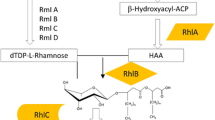Abstract
In this study, a wild-type Pseudomonas aeruginosa strain KT1115 with the capability of converting rapeseed oils into di-rhamnolipids, a class of biosurfactants with extensive application potential, was successfully isolated and characterized. Di-rhamnolipids production by microorganism culture provided a mild, eco-friendly, and secure approach for surfactants production instead of conventional chemical synthesis. However, few studies have been attempted to explore the metabolic mechanism behind the high di-rhamnolipids production by P. aeruginosa. Here, we presented the graft genome of a wild-type P. aeruginosa strain KT1115, with emphasis on the analysis of oils metabolism and rhamnolipid synthesis. The availability of the genome sequence provides additional insight into the genetic mechanism enhancing di-rhamnolipids biosynthesis.



Similar content being viewed by others
References
Mulligan C, Yong R, Gibbs B (2001) Surfactant-enhanced remediation of contaminated soil: a review. Eng Geol 60:371–380
Henkel M, Müller MM, Kügler JH, Lovaglio RB, Contiero J, Syldatk C, Hausmann R (2012) Rhamnolipids as biosurfactants from renewable resources: concepts for next-generation rhamnolipid production. Process Biochem 47:1207–1219
Wadekar S, Kale S, Lali A, Bhowmick D, Pratap A (2012) Microbial synthesis of rhamnolipids by Pseudomonas aeruginosa (ATCC 10145) on waste frying oil as low cost carbon source. Prep Biochem Biotechnol 42:249–266
Tan YN, Li Q (2018) Microbial production of rhamnolipids using sugars as carbon sources. Microb Cell Factories 17:89
Muller MM, Hormann B, Syldatk C, Hausmann R (2010) Pseudomonas aeruginosa PAO1 as a model for rhamnolipid production in bioreactor systems. Appl Microbiol Biotechnol 87:167–174
Jie Z, Xue R, Liu S, Xu N, Xin F, Zhang W, Jiang M, Dong W (2019) High di-rhamnolipid production using Pseudomonas aeruginosa KT1115, separation of mono/di-rhamnolipids, and evaluation of their properties. Front Bioeng Biotechnol 7:245
Lopez G, Diaz-Cardenas C, Shapiro N, Woyke T, Kyrpides NC, David Alzate J, Gonzalez LN, Restrepo S, Baena S (2017) Draft genome sequence of Pseudomonas extremaustralis strain USBA-GBX 515 isolated from Superparamo soil samples in Colombian Andes. Stand Genomic Sci 12:78
Schubert M, Lindgreen S, Orlando L (2016) AdapterRemoval v2: rapid adapter trimming, identification, and read merging. BMC Res Notes 9:88
Khan AL, Asaf S, Khan AR, Al-Harrasi A, Al-Rawahi A, Lee I-J (2016) First draft genome sequencing of indole acetic acid producing and plant growth promoting fungus Preussia sp. BSL10. J Biotechnol 225:44–45
Sun C, Li Y, Wu Q, Luo H, Sun Y, Song J, Lui EM, Chen S (2010) De novo sequencing and analysis of the American ginseng root transcriptome using a GS FLX Titanium platform to discover putative genes involved in ginsenoside biosynthesis. BMC Genomics 11:262
Lowe TM, Eddy SR (1997) tRNAscan-SE: a program for improved detection of transfer RNA genes in genomic sequence. Nucleic Acids Res 25:955
Jaeger KE, Ransac S, Dijkstra BW, Colson C, van Heuvel M, Misset O (1994) Bacterial lipases. FEMS Microbiol Rev 15:29–63
Dobler L, Vilela LF, Almeida RV, Neves BC (2016) Rhamnolipids in perspective: gene regulatory pathways, metabolic engineering, production and technological forecasting. N Biotechnol 33:123–135
Deziel E, Lepine F, Milot S, Villemur R (2003) rhlA is required for the production of a novel biosurfactant promoting swarming motility in Pseudomonas aeruginosa: 3-(3-hydroxyalkanoyloxy) alkanoic acids (HAAs), the precursors of rhamnolipids. Microbiology 149:2005–2013
Rahim R, Ochsner UA, Olvera C, Graninger M, Messner P, Lam JS, Soberón-Chávez G (2001) Cloning and functional characterization of the Pseudomonas aeruginosa rhlC gene that encodes rhamnosyltransferase 2, an enzyme responsible for di-rhamnolipid biosynthesis. Mol Microbiol 40:708–718
Winsor GL, Lam DK, Fleming L, Lo R, Whiteside MD, Yu NY, Hancock RE, Brinkman FS (2010) Pseudomonas Genome Database: improved comparative analysis and population genomics capability for Pseudomonas genomes. Nucleic Acids Res 39:D596–D600
Abdel-Mawgoud AM, Lépine F, Déziel E (2014) A stereospecific pathway diverts β-oxidation intermediates to the biosynthesis of rhamnolipid biosurfactants. Chem Biol 21:156–164
Raychaudhuri A, Tullock A, Tipton PA (2008) Reactivity and reaction order in acylhomoserine lactone formation by Pseudomonas aeruginosa RhlI. Biochemistry 47:2893–2898
Kambam PKR, Eriksen DT, Lajoie J, Sayut DJ, Sun L (2009) Altering the substrate specificity of RhlI by directed evolution. ChemBioChem 10:553–558
Rosenau F, Jaeger K-E (2000) Bacterial lipases from Pseudomonas: regulation of gene expression and mechanisms of secretion. Biochimie 82(11):1023–1032
Zhang B, Ren L, Xu D, Wang H, Chen Z, Zhang B, Zeng X, Sun L, Li F (2020) Directed evolution of RhlI to generate new and increased quorum sensing signal molecule catalytic activities. Enzyme Microb Technol 134:109475
Moretti R, Chang A, Peltier-Pain P, Bingman CA, Phillips GN Jr, Thorson JS (2011) Expanding the nucleotide and sugar 1-phosphate promiscuity of nucleotidyltransferase RmlA via directed evolution. J Biol Chem 286:13235–13243
Reis RS, Pereira AG, Neves BC, Freire DMG (2011) Gene regulation of rhamnolipid production in Pseudomonas aeruginosa—a review. Bioresour Technol 102:6377–6384
Acknowledgements
This work was financially supported by the National Key R&D Program of China (No. 2018YFA0902200), National Natural Science Foundation of China (Nos. 31961133017, 31700092, 21978129), the Natural Science Foundation of Jiangsu Province (No. BK20170997), the Jiangsu Synergetic Innovation Center for Advanced Bio-Manufacture, Jiangsu Agriculture Science and Technology Innovation Fund [NO. CX (19)3104], Project of State Key Laboratory of Materials-Oriented Chemical Engineering (No. ZK201601).
Author information
Authors and Affiliations
Corresponding author
Ethics declarations
Conflict of interest
The authors have declared that they have no conflict of interest.
Additional information
Publisher's Note
Springer Nature remains neutral with regard to jurisdictional claims in published maps and institutional affiliations.
Nucleotide Sequence Accession Numbers
This Whole Genome project has been deposited into GenBank database under the Accession Number WUWO00000000. The chromosome is under the accession of MK386864.
Rights and permissions
About this article
Cite this article
Liu, S., Xu, N., Liu, H. et al. Genome Characterization of Pseudomonas aeruginosa KT1115, a High Di-rhamnolipid-Producing Strain with Strong Oils Metabolizing Ability. Curr Microbiol 77, 1890–1895 (2020). https://doi.org/10.1007/s00284-020-02009-z
Received:
Accepted:
Published:
Issue Date:
DOI: https://doi.org/10.1007/s00284-020-02009-z




